Philodendron and Pothos, two popular houseplants that are often confused with each other. What separates these two favorite plants is the details. While they are very similar in some areas, there are key differences that set them apart.
Both plants are easy to care for and have trailing vines with glossy, green leaves, but there's more to look for if you want to call them by name. In this guide, we'll explore the characteristics of both plants and provide you with an expert guide to telling the difference between a philodendron and a pothos.
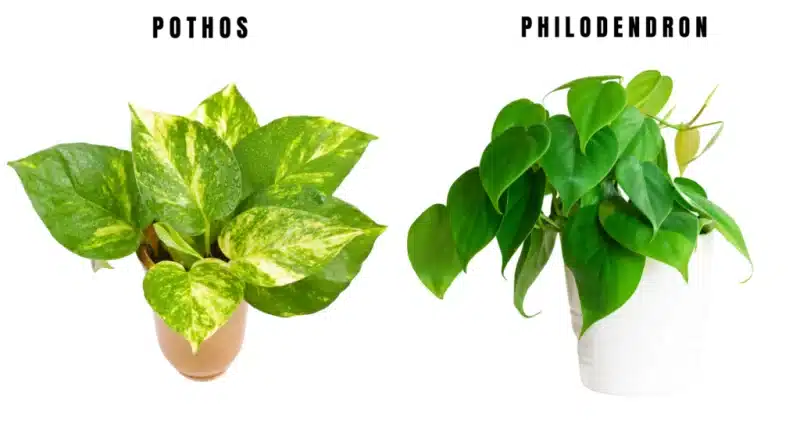
Introducing the Philodendron
Philodendrons are a group of popular and easy-to-care-for houseplants that belong to the Araceae family. These tropical plants are native to Central and South America, and they are loved for their lush, green foliage and ability to purify the air.
The name “Philodendron” comes from the Greek words “philos” which means love, and “dendron” which means tree. However, despite its name, the philodendron is not actually a tree, but rather a climbing vine that can be trained to grow on a trellis or allowed to cascade over a pot.
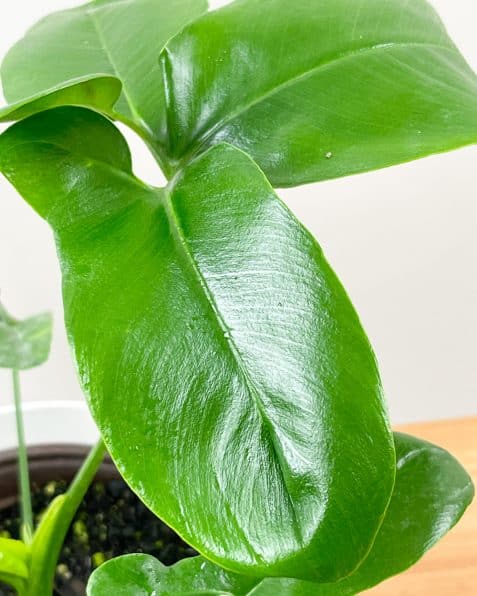
The leaves of the philodendron can come in a variety of shapes, sizes, and colors, but they are generally broad and glossy. Some species have deeply lobed leaves, while others have heart-shaped leaves or long, slender leaves. Many philodendrons also have aerial roots that help them climb and absorb nutrients from their environment. These plants are relatively low-maintenance and can thrive in a range of lighting conditions, making them a popular choice for both novice and experienced plant owners alike. Whether you're looking to add some greenery to your home or office, a philodendron is a great choice.
Introducing the Pothos
Pothos, also known as Devil's Ivy, is a popular and easy-to-care-for houseplant that belongs to the Araceae family. This tropical plant is native to Southeastern Asia and is known for its trailing vines with heart-shaped, glossy leaves. The leaves of the pothos can come in a range of colors, including shades of green, yellow, and white, which can make for a striking display when grouped together.

Pothos is a great choice for beginner house plant enthusiasts, as it is low-maintenance and can thrive in a range of lighting conditions, from low to bright indirect light. It is also highly adaptable to different temperatures and humidity levels, making it a versatile plant that can be grown in various locations around the home or office.
Key Similarities and Differences Between Pothos and Philodendron Plants
Similarities:
- Both Pothos and Philodendron are tropical plants that are native to South America.
- Both plants are members of the Araceae family.
- Both plants are known for their lush foliage and easy care requirements.
- Both plants can be grown in a variety of conditions, including low light and low humidity.
- Both plants are relatively pest- and disease-resistant.
Differences:
- Leaf Shape: Pothos leaves are typically more elongated and less uniform in shape, while Philodendron leaves tend to be more heart-shaped and uniform.

- Leaf Texture: Pothos leaves have a shiny, waxy finish, while Philodendron leaves have a softer, matte finish.
- New Growth: Philodendron plants produce new leaves from protected cataphylls, while Pothos plants produce new leaves that uncurl from the previous leaf.
- Aerial Roots: Pothos plants have thicker, black aerial roots, while Philodendron plants have thinner, stringy aerial roots that cluster together.
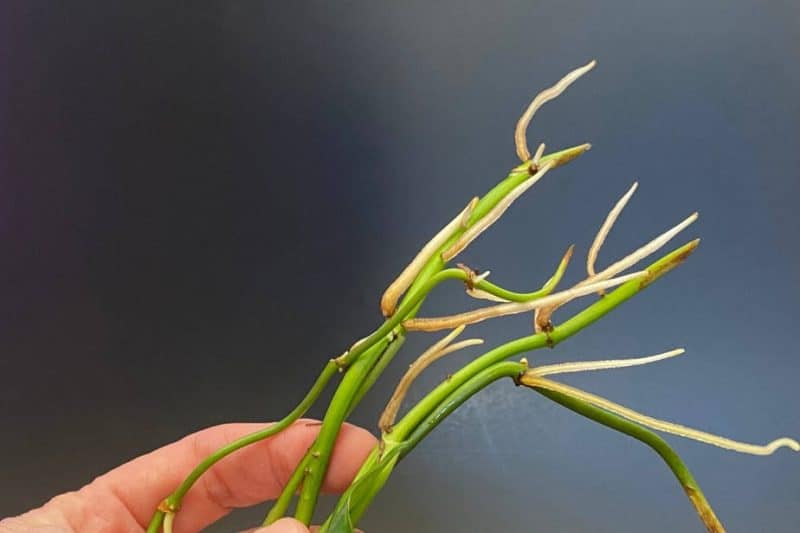
- Stem Thickness: Pothos stems are thicker than Philodendron stems.
- Petiole: Pothos petioles are thicker and have a deep ridge, while Philodendron petioles are more round and smooth.
| Pothos Plants | Philodendron Plants |
|---|---|
| Heart-shaped leaves with shorter, less pointed tipsThicker, shiny leaves with a waxy finishA well-defined, deep ridge down the center of the leaf due to their thick and ridged petioleAerial roots appear as thick black nubs, with only one per nodeThicker stems that are usually the same color as the leavesPetioles are thicker and have the same or slightly lighter green color than the rest of the foliage | More elongated, spear-shaped leaves with longer, spout-like tipsSofter leaves with a smooth, matte finishLack the deep ridge down the center of the leaf due to their more flat petioleAerial roots are thinner and occur in clusters, resembling an above-ground root systemDaintier stems with a brownish-orange colorPetioles are more round and smooth down the entire length and into the leaf and often appear more brownish than the leaves |
| Both |
|---|
| Both are popular houseplants and are relatively easy to care for.Both can tolerate low light conditions, although they will grow more slowly and may not produce as many leaves in low light.Both plants can be propagated easily through stem cuttings.Both plants are known to purify the air, removing toxins such as formaldehyde and benzene from the surrounding environment.Both plants can be trained to climb walls, trellises or other structures, creating a beautiful and green decorative feature.Both plants will produce aerial roots along their stems, which help anchor the plant and absorb nutrients and moisture from the air.Both plants can be toxic if ingested, so it is important to keep them out of reach of children and pets.Both plants can benefit from occasional misting to increase humidity around the foliage. |
Let’s Break it Down: Philodendron vs Pothos
When we begin to break it down concerning the similarities and the differences between Philodendron and Pothos we can look at several factors for a start.
- Taxonomy
- Leaf characteristics
- Root system
- Stem similarities and differences
- Care Guides for each plant
1. What’s in a Name? Botanical vs Common
The difference between the botanical name and the common name of a plant can be significant, and understanding the distinction between the two is important for accurate identification.
The botanical name of a plant is a scientific name that is used to identify a particular species of plant, and it consists of two parts: the genus and the species. Botanical names are standardized and recognized worldwide, allowing for clear and accurate communication about a particular plant species regardless of language or region.
Common names of plants can vary depending on location, culture, and language. Common names can sometimes be misleading or confusing, as multiple plants may share the same common name in different regions or languages.
2. Leaves
At first glance, there are several characteristics of the leaf textures and shapes that make it easy to differentiate them. These leaf differences are especially noticeable in the area where the petiole connects to the base of the leaf. Here are the key variations between the two:
- Philodendron leaves are:
- Thin with a very smooth texture — you will not feel any bumps or raised surfaces here like you would with a pothos plant.
- Symmetrical and heart-shaped with a prominent pointed end.
- Plain green in color

- Pothos leaves are:
- Thicker and have a waxy, bumpy texture, as compared to the philodendron.
- Asymmetrical and can also be a lot larger than the philodendron plant.
- Marked with gold, white, or yellow markings on their leaves.
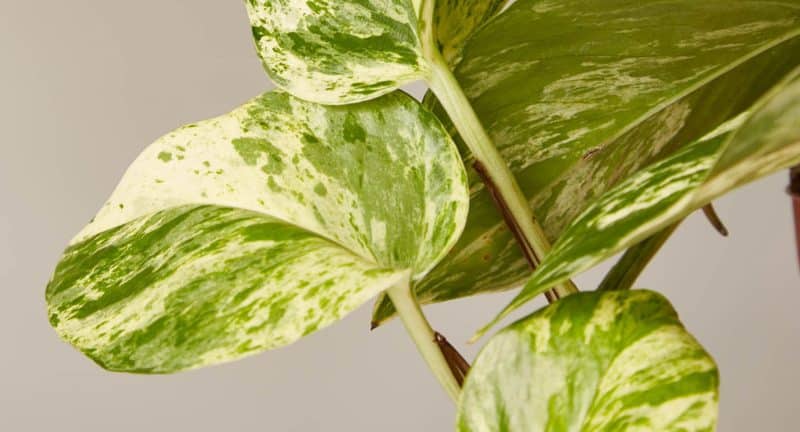
3. Roots & Stems
When it comes to roots and stems, philodendrons and pothos have some similarities and differences.
Similarities:
- Both plants have aerial roots that can attach to supports or grow along the ground.
- Both plants have long, trailing stems that can grow several feet in length.
- Both plants can be propagated by stem cuttings, making them easy to propagate and share with friends.
Differences:
- Philodendrons have thicker, more rigid stems that can be woody and even develop nodes or “knees” in some species. Pothos stems are thinner and more flexible, often with a more vine-like appearance.
- Philodendrons have roots that can grow quite thick and have a velvety texture, while pothos roots are typically thinner and smoother.
- Philodendrons are more likely to grow upright, while pothos tends to grow horizontally or even cascade down from their pot or support.

4. Caring for the Plants
When it comes to care and maintenance, philodendrons and pothos have some similarities and differences.
Similarities:
- Both plants are relatively low-maintenance and can tolerate low light conditions.
- Both plants prefer well-draining soil and should not be overwatered.
- Both plants benefit from occasional pruning to encourage fuller growth and prevent legginess.
- Both plants are susceptible to pest infestations, such as spider mites and mealybugs, and should be monitored regularly.
Differences:
- Philodendrons are generally more tolerant of neglect and can go longer periods between waterings than pothos, which prefer to be kept slightly more consistently moist.
- Philodendrons are more susceptible to root rot if overwatered, while pothos is more tolerant of occasional overwatering.
- Some species of philodendron, such as the Tree Philodendron or Selloum, can grow quite large and may require more space and maintenance than pothos.
- Pothos can be more forgiving of lower humidity levels, while some species of philodendron prefer higher humidity.
5. What else?
| Feature | Pothos | Philodendron |
|---|---|---|
| Petiole shape | Indented and curved inward | Rounded and smooth |
| Petiole thickness | Thicker | Thinner |
| Petiole color | Same color as leaves | Different color than leaves |
| Root shape | Thick nubs | Thin and spindly |
| Number of roots per node | One | More than one |
| Light | Bright, indirect light | Bright, indirect light or low light |
Philodendron and Pothos Plant Varieties
Philodendron and Pothos are two popular plant genera with a wide variety of species and cultivars. In this section, we will take a closer look at some of the most popular varieties of Philodendron and Pothos plants and some of their unique features.
Philodendron Varieties
- Philodendron Birkin: This variety features dark green, glossy leaves with bright white variegation. The variegation tends to be most pronounced on newer growth and can become more muted as the leaves mature.
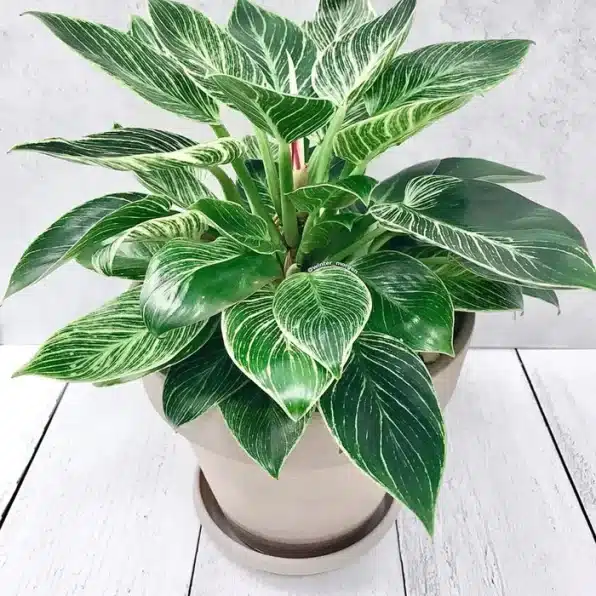
- Philodendron Splendid: This variety has large, glossy, dark green leaves with deep, pronounced lobes. The leaves can grow up to 12 inches in length and the plant can grow up to 3 feet tall.
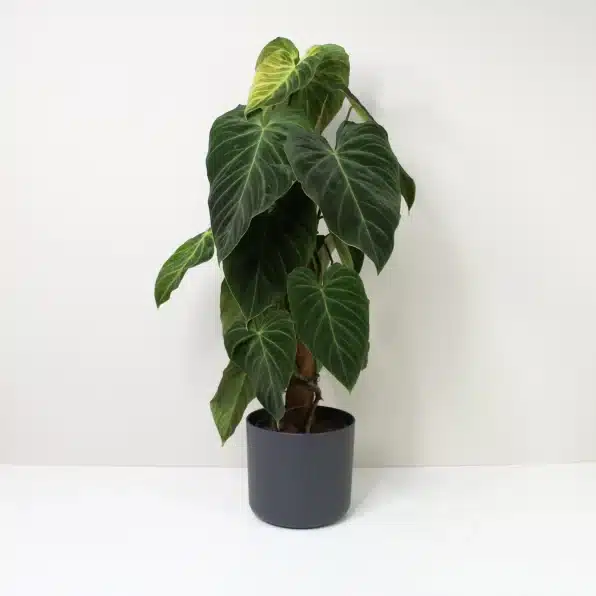
- Philodendron Rugosum: This variety is also known as the “wrinkled-leaves philodendron” due to its thick, textured leaves. The leaves are dark green and heart-shaped, and the plant can grow up to 2-3 feet tall.

- Philodendron Plowmanii: This variety has elongated, lance-shaped leaves that are a deep green color. The leaves can grow up to 2-3 feet long and the plant can grow up to 6 feet tall.

- Philodendron Brasil: This variety features green leaves with yellow variegation, which can vary in intensity depending on light levels. The variegation tends to be most pronounced on newer growth. Brasil philodendrons prefer bright, indirect light and well-draining soil. They can be propagated by stem cuttings or division.
Pothos Varieties
- Golden Pothos (Epipremnum aureum): This is the most common variety of pothos and is known for its heart-shaped leaves with variegated green and yellow coloring.
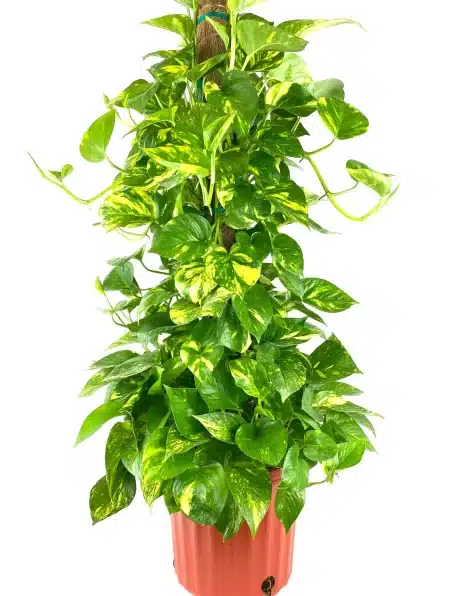
- Marble Queen Pothos (Epipremnum aureum ‘Marble Queen’): This variety has striking variegation with white and green leaves that have a marbled appearance.
- Neon Pothos (Epipremnum aureum ‘Neon’): As its name suggests, this variety has bright neon green leaves that can add a pop of color to any room.
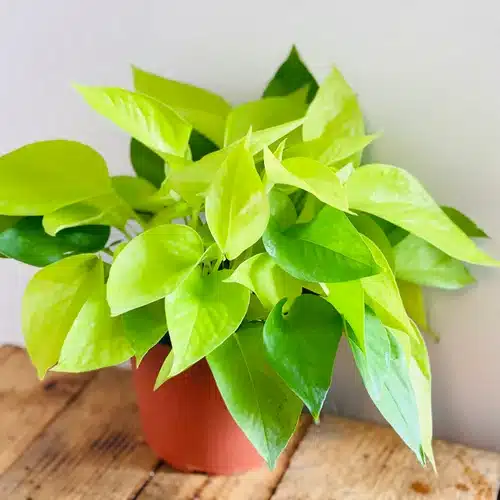
- Jade Pothos (Epipremnum aureum ‘Jade’): This variety has glossy, dark green leaves that are more solid in color than other pothos varieties.
- Pearls and Jade Pothos (Epipremnum aureum ‘Pearls and Jade’): This variegated variety has green and white leaves with speckles of silver and cream, giving it a unique and eye-catching appearance.
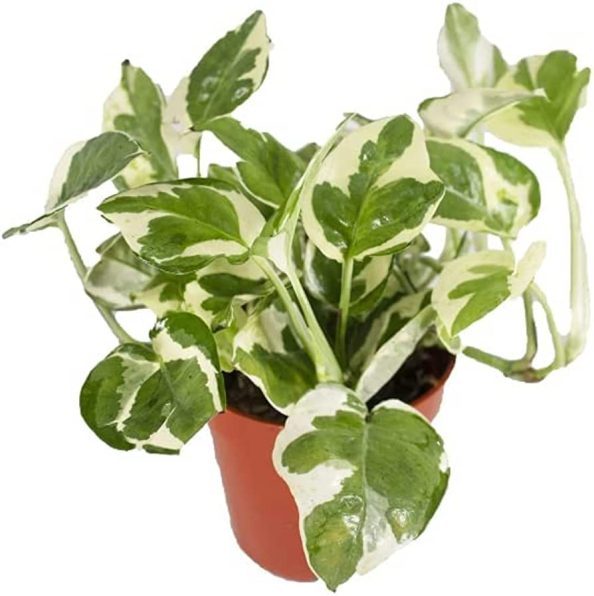
Philodendron vs Pothos FAQ’s
Which plant is easier to care for, Pothos or Philodendron?
Both Pothos and Philodendron plants are relatively easy to care for and are great for beginners. They are low-maintenance plants that are tolerant of a wide range of lighting and watering conditions.
What is the difference between Philodendron and Pothos leaves?
Philodendron leaves are generally softer and have a smooth matte finish, while Pothos leaves are thicker with a shiny, almost waxed-like finish and have a more raised and bumpy texture on the top.
Can Philodendron and Pothos grow together?
Although slightly different in character, yes, you can grow these two plants together.
Which is better, philodendron or pothos plants?
Although both are considered easy to care for, Philodendrons tolerate lower light and might be a better choice for some situations.

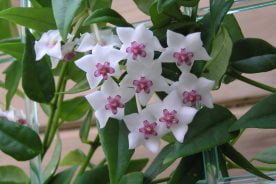
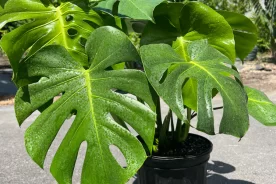


No Comments